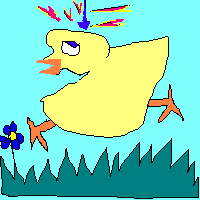

The Jaguar and Chicken Little: Teaching Using Stories by Dr. Selia Karsten
Increasingly we instruct using computer technology. Here's an old fashioned and very effective teaching strategy. Storytelling grabs students' attention! Come hear stories used effectively in three courses: How to be a Successful Student; Effective Business Presentations; Career Launching and Portfolios. In this session, expect to build story resources and spark teaching ideas for using stories in your classes.
Most of my classes are conducted
in computer labs, online or at the very least, in electronic classrooms.
I need to capture students' attention and help them learn. Harking back
to ancient times when tales of the hunt dominated cave communications -
this session underscores the power of stories. The transferable skills
gained in my first, second and fifth semester marketing courses could fit
into any college program - I've found nifty story solutions for each.
Stories that help us connect with students and promote bonding are those where we use story to hook the learner, engaging them in such a way that they can see the teacher as an ally or collaborator in their learning journey. Stories that are disconnecting stories are those that help us close the gaps and win back attention when a chasm has opened up separating us from our learners.
The stories we use may be true life experiences (our own or stories where we know the characters in the story) or we can use stories from the universal collection - folk tales, myths, legends, urban legends, anecdotes, nursery rhymes, new stories, children's stories, fairy tales, ghost stories. Song lyric stories, historical tidbits, biographical sketches, movie treatments.
Activities around stories can be pocket stories, surprise bag stories, postcard stories, cartoons needing captions and stories, taped stories, continuing stories, pass the ball of yarn stories, nature object stories. Stories that change over time. Stories from other languages. Number stories. Geography stories. Name your subject, topic, theme stories. Music or painting stories. Skits. Tableaus.
How to Be a Successful
Student http://people.senecac.on.ca/selia.karsten/SSC/100f2004.html
In this course, I cover
topics like time management, setting goals, taking notes, conducting research,
taking exams, relationships, fitness, decision-making, money-management,
etc. engagingly. The major challenge is to cover topics that will
help students to be better more effective learners during their college
career and hopefully develop into life long learners. They come thinking
they already know how to do everything but quickly discover there is much
room for improvement. It's important to make the class sessions fun and
engaging in order to get students to attend regularly and participate for
an hour and three quarters each week. I use two stories that work well
to get across effective listening, observing, note-taking, and passing
a quiz. The first story is one that has a lot of concepts unfamiliar to
students related to college programs and graduate study at the university.
The second story is the Jaguar adventure. The Jaguar
story wows them! They are given a chance to review any notes
they have taken then they take a short quiz covering the two talks. This
leads us to a discussion of the different types of lectures and stories
teachers tell and how to decide what is important to remember and note
to review for future tests.
Effective Business Presentations
http://people.senecac.on.ca/selia.karsten/MRK/224w2005.html
This course has students
on their feet in front of an audience six times during the semester.
Storytelling activities with these novice presenters go a long way to helping
them make breakthroughs in public speaking both as a team member and individually.
I lead off with the jaguar story and it easily gets the attention of the
students. We have a productive discussion about the various elements that
they believe made the story a good one and what techniques I used as a
storyteller that might work for a presenter. I also build a simple
power point version of the jaguar story to demonstrate how easy it is to
build a visual aid for presenting. Here's one Power
Point version of the Jaguar Story.
In small groups, the students tell stories to each other. One of the activities is to have each small group of storytellers choose one of the stories. Then two members of the group get up in front of the class and tell the same story with great conviction. The class has to guess whose story it really belongs to and why they think so based on the storyteller's techniques. Once you have tried one of the activities suggested in the session, you'll likely think of many more ways in which you can use storytelling activities in your classes.
Career Launching and Portfolios
http://people.senecac.on.ca/selia.karsten/CAP/506f2004.html
By fifth semester, students
should have had a lot of experience in working as part of a team and in
presenting. They are about to need it as they go out into the working world
to present themselves to potential employers. Going beyond the usual polishing
of job search skills, students learn what has actually happened to a variety
of marketing graduates. Each team identifies, selects, interviews and documents
the working life of a marketing graduate. Relevant artifacts are used to
build an electronically enhanced portrait or profile for presentation in
class. What students learn is reflected as they build their own professional
portfolios and eportfolios. Coursework is monitored in weekly forty-five
minute meetings; career centre workshops and online discussion postings
in BlackBoard.
At one point, several weeks
into the semester, a few students with a "been there, done that" attitude
began to think they didn't need the course and furthermore began to panic
about
all of the workload for the semester. Panic set in and students wanted
to opt out of my course because they had too many other "really important
things to do. I created a little slide show called CAP506
made Easy and sent it to each student by e-mail. When they
came to class (45 minutes) I put the slide show up on the screen and reviewed
it. Chicken
Little saved the day. I brought up the Chicken Little sites I found
and reminded them of this children's story. Quite a few students
recognized the story from their childhood. We talked about how important
it is not to get overly dramatic about the stresses of their workload.
I suggested making a chart that would show them each class and all of their
projects with due dates for the rest of the weeks in the semester.
This way they could get a realistic view of what they had to do and when.
March 2005
drkarsten@astralsite.com
Back
to Astralsite Projects